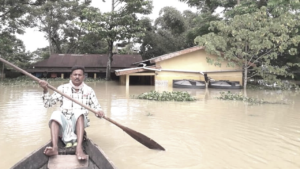Physical Address
23,24,25 & 26, 2nd Floor, Software Technology Park India, Opp: Garware Stadium,MIDC, Chikalthana, Aurangabad, Maharashtra – 431001 India
Physical Address
23,24,25 & 26, 2nd Floor, Software Technology Park India, Opp: Garware Stadium,MIDC, Chikalthana, Aurangabad, Maharashtra – 431001 India

“This time, somehow, it is different. The rain gods have never been so merciless. Can’t remember the last time, it rained so much in such a short time,” said Mukut Das, a marginal farmer from the Morigaon district in Assam. Das might not realize the ‘climate change’ related implications of his statement but it actually sums up how a change in climatic conditions has played a major role in the recent wave of unprecedented floods in Assam and its surrounding states.

TOO MUCH RAIN IN TOO LITTLE TIME
This year, the pre-monsoon was uncommonly wetter in Assam and between March 1 and May 27, 754.3 mm of rainfall was recorded in the state. This was 48% higher than its average for this period. In the month of May, Assam received 56% more rainfall than normal and the cumulative rainfall in the first 12 days of June was 528.5 mm which was in excess of 109%. In the third week of June, Assam, Meghalaya, and Arunachal Pradesh recorded 170, 203, and 65 percent excess rain, respectively. Cherrapunji in Meghalaya received 972 mm of rainfall in 24 hours on June 17, the third-highest in 122 years according to the India Meteorological Department (IMD). That is a lot of rainfall within a very short period of time.
Roxy Mathew Koll, who is a climate scientist at the Indian Institute of Tropical Meteorology wrote for the Times of India, “Monsoon patterns have seen a climatic shift over South Asia since the 1950s. The most significant change is that instead of having moderate rains spread out through the monsoon seasons, we have long dry periods interspersed with short spells of heavy rains- since the moisture-holding capacity of the air has increased with global warming.”
He further explained how it does not rain for a long time and when it does, all the moisture is dumped in a few hours to a few days resulting in the fact that we get the whole month’s rain in a day or two.
According to a study conducted in 2017 by the Pune-based Indian Institute of Tropical Meteorology based on IMD data, the average monsoon rainfall is witnessing a decreasing trend in Assam since 1870. The authors of the study have further explained that the daily rainfall data clearly indicates the increase in sudden downpour days, short spells of heavy rains, resulting in extreme events of flooding in several parts of the Brahmaputra valley.
CLIMATE CHANGE AND FLOODS
Over the last few weeks, Assam and some of its neighboring states have witnessed unprecedented rainfall activity in the month of May and June followed by the fury of floods and erosion. The situation is anything but normal, according to experts.
According to Roxy Mathew Koll, the large amount of rainfall that has been witnessed in Northeast India might be the result of global warming and climate change.
The formation of a negative Indian Ocean Dipole (IOD) in the Indian Ocean together with the ongoing La Nina event in the Pacific has strengthened south-westerlies in the Bay of Bengal, he explained to the magazine Down to Earth. (La Nina conditions occur when the ocean temperatures in the central-eastern Pacific region are cooler than usual. Negative IOD occurs when the Indian Ocean is cool in the west and warm in the east.)
“These strong monsoon winds in the Bay of Bengal can now carry much more moisture than ever before, in response to global warming,” the climate scientist told the magazine.
“The volume of atmospheric moisture increases with rising temperature because warmer air holds more moisture for longer. Hence, the large amount of rainfall that we see now might be a climate change impact,” he further said.
NORTHEAST STATES LIKE ASSAM MOST VULNERABLE
According to the latest data on July 4, 179 people lost their lives in Assam due to floods and landslides, and around 18.35 lakh people are still affected. 2,78,060 people have taken shelter in 413 relief camps in 20 districts of the state.
Multiple reports have already stressed that India is prone to extreme weather events like unusually heavy rainfall leading to extreme flooding. The UN-backed Intergovernmental Panel on Climate Change (IPCC) has highlighted this.
A Climate Vulnerability Index of the Council on Energy, Environment, and Water (CEEW) names Assam among the states as the most vulnerable to extreme climate events like flooding. This report further states that Northeast India is more prone to floods in the country.
Category:
Comments are closed.
[…] English | Assamese […]
Itís hard to find well-informed people on this subject, but you seem like you know what youíre talking about! Thanks
[…] English | Assamese […]